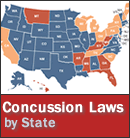Calif. Gov. Jerry Brown signed a law last week that prohibits high school and middle school football coaches from conducting more than two full-contact football practices per week.
The law, which the state Senate passed by a vote of 23-5 in mid-June, applies to the regular season and preseason in school districts and at charter schools and private schools. Middle and high school coaches also may not exceed 90 minutes of full-contact practice on any given day, and cannot hold a full-contact practice at any point during the offseason.
The law defines a full-contact practice as “a practice where drills or live action is conducted that involves collisions at game speed, where players execute tackles and other activity that is typical of an actual tackle football game.”
Earlier this month, the NCAA and College Athletic Trainers’ Society released guidelines that recommended limiting live-contact football practices to two per week during the regular season, postseason, and college football bowl season. The NCAA also suggested schools that hold two-a-day practices in the preseason should hold no more than one full-contact practice per day. The Ivy League implemented a similar reduction in regular-season full-contact practices back in 2011, and the Pac-12 Conference announced its intention to follow suit last summer.

The NCAA additionally recommended a stepwise progression for concussed student-athletes returning to both athletic competition and academics. California’s new law is one step ahead of the game in that regard; it requires any student-athlete diagnosed with a concussion to complete a “graduated return-to-play protocol of no less than seven days in duration under the supervision of a licensed health care provider.”
Three major sets of sports-related concussion guidelines and/or position statements released in 2013 (from the American Medical Society for Sports Medicine, the American Academy of Neurology, and the Zurich Consensus working group) all recommended a graduated return-to-play protocol for concussed youth-athletes. The Zurich statement suggested that as a student-athlete recovers from a concussion, “school attendance and activities may also need to be modified to avoid provocation of symptoms.” The AMSSM similarly recommended that while recovering from a concussion, “students will require cognitive rest and may require academic accommodations such as reduced workload and extended time for test while recovering from a concussion.”
Most states’ laws simply specify that student-athletes diagnosed with a concussion cannot return to play the day of their diagnosis. So long as they’re cleared by a licensed health care professional, there’s nothing preventing them from returning the next day.
While California’s new law only focuses on the athletic component of a return-to-play protocol (and does not touch upon academics), it’s a sign of progress for a state to recognize the need for a formalized graduated return-to-play protocol. It’s not exactly breaking news to say that some students aren’t entirely forthcoming when it comes to reporting concussion symptoms—a majority of Washington state high school football and girls’ soccer players reporting playing with concussion symptoms during the 2012 fall season—so a graduated return-to-play protocol helps protect student-athletes from themselves.